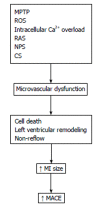Cardioprotection and pharmacological therapies in acute myocardial infarction: Challenges in the current era
- PMID: 24669291
- PMCID: PMC3964186
- DOI: 10.4330/wjc.v6.i3.100
Cardioprotection and pharmacological therapies in acute myocardial infarction: Challenges in the current era
Abstract
In patients with an acute ST-segment elevation myocardial infarction, timely myocardial reperfusion using primary percutaneous coronary intervention is the most effective therapy for limiting myocardial infarct size, preserving left-ventricular systolic function and reducing the onset of heart failure. Within minutes after the restoration of blood flow, however, reperfusion itself results in additional damage, also known as myocardial ischemia-reperfusion injury. An improved understanding of the pathophysiological mechanisms underlying reperfusion injury has resulted in the identification of several promising pharmacological (cyclosporin-A, exenatide, glucose-insulin-potassium, atrial natriuretic peptide, adenosine, abciximab, erythropoietin, metoprolol and melatonin) therapeutic strategies for reducing the severity of myocardial reperfusion injury. Many of these agents have shown promise in initial proof-of-principle clinical studies. In this article, we review the pathophysiology underlying myocardial reperfusion injury and highlight the potential pharmacological interventions which could be used in the future to prevent reperfusion injury and improve clinical outcomes in patients with coronary heart disease.
Keywords: Adjunctive therapy; Cardioprotection; Infarct size; Myocardial reperfusion injury; ST-elevation myocardial infarction.
Figures

References
-
- Buja LM, Weerasinghe P. Unresolved issues in myocardial reperfusion injury. Cardiovasc Pathol. 2010;19:29–35. - PubMed
-
- Worner F, Cequier A, Bardají A, Bodí V, Bover R, Martínez-Sellés M, Sabaté M, Sionis A, Vázquez de Prada JA, Arós F, et al. Comments on the ESC Guidelines for the Management of Acute Myocardial Infarction in Patients Presenting With ST-Segment Elevation. Rev Esp Cardiol. 2013;66:5–11. - PubMed
-
- Mandelzweig L, Battler A, Boyko V, Bueno H, Danchin N, Filippatos G, Gitt A, Hasdai D, Hasin Y, Marrugat J, et al. The second Euro Heart Survey on acute coronary syndromes: Characteristics, treatment, and outcome of patients with ACS in Europe and the Mediterranean Basin in 2004. Eur Heart J. 2006;27:2285–2293. - PubMed
-
- Buja LM. Myocardial ischemia and reperfusion injury. Cardiovasc Pathol. 2005;14:170–175. - PubMed
Publication types
LinkOut - more resources
Full Text Sources
Other Literature Sources

